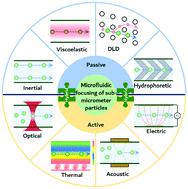Our official English website, www.x-mol.net, welcomes your feedback! (Note: you will need to create a separate account there.)
Focusing of sub-micrometer particles in microfluidic devices.
Lab on a Chip ( IF 6.1 ) Pub Date : 2019-11-07 , DOI: 10.1039/c9lc00785g Tianlong Zhang 1 , Zhen-Yi Hong 2 , Shi-Yang Tang 3 , Weihua Li 3 , David W Inglis 4 , Yoichiroh Hosokawa 2 , Yaxiaer Yalikun 2 , Ming Li 4
Lab on a Chip ( IF 6.1 ) Pub Date : 2019-11-07 , DOI: 10.1039/c9lc00785g Tianlong Zhang 1 , Zhen-Yi Hong 2 , Shi-Yang Tang 3 , Weihua Li 3 , David W Inglis 4 , Yoichiroh Hosokawa 2 , Yaxiaer Yalikun 2 , Ming Li 4
Affiliation

|
Sub-micrometer particles (0.10–1.0 μm) are of great significance to study, e.g., microvesicles and protein aggregates are targets for therapeutic intervention, and sub-micrometer fluorescent polystyrene (PS) particles are used as probes for diagnostic imaging. Focusing of sub-micrometer particles – precisely control over the position of sub-micrometer particles in a tightly focused stream – has a wide range of applications in the field of biology, chemistry and environment, by acting as a prerequisite step for downstream detection, manipulation and quantification. Microfluidic devices have been attracting great attention as desirable tools for sub-micrometer particle focusing, due to their small size, low reagent consumption, fast analysis and low cost. Recent advancements in fundamental knowledge and fabrication technologies have enabled microfluidic focusing of particles at sub-micrometer scale in a continuous, label-free and high-throughput manner. Microfluidic methods for the focusing of sub-micrometer particles can be classified into two main groups depending on whether an external field is applied: 1) passive methods, which utilize intrinsic fluidic properties without the need of external actuation, such as inertial, deterministic lateral displacement (DLD), viscoelastic and hydrophoretic focusing; and 2) active methods, where external fields are used, such as dielectrophoretic, thermophoretic, acoustophoretic and optical focusing. This article mainly reviews the studies on the focusing of sub-micrometer particles in microfluidic devices over the past 10 years. It aims to bridge the gap between the focusing of micrometer and nanometer scale (1.0–100 nm) particles and to improve the understanding of development progress, current advances and future prospects in microfluidic focusing techniques.
中文翻译:

在微流控设备中聚焦亚微米颗粒。
亚微米颗粒(0.10–1.0μm)对研究具有重要意义,例如微囊和蛋白质聚集体是治疗干预的目标,亚微米荧光聚苯乙烯(PS)颗粒用作诊断成像的探针。亚微米颗粒的聚焦-精确控制紧密聚焦流中亚微米颗粒的位置-通过充当下游检测,操作的前提步骤,在生物学,化学和环境领域具有广泛的应用和量化。由于微流体装置尺寸小,试剂消耗低,分析速度快和成本低,作为亚微米颗粒聚焦的理想工具已经引起了广泛的关注。基础知识和制造技术的最新进展已实现了以亚微米级连续,连续地对颗粒进行微流控聚焦,无标签和高通量方式。根据是否施加外部场,用于聚焦亚微米颗粒的微流体方法可分为两大类:1)被动方法,利用固有的流体特性而无需外部驱动,例如惯性,确定性的横向位移(DLD),粘弹性和电泳聚焦;2)主动方法,使用外部电场,例如介电泳,热电泳,声电泳和光学聚焦。本文主要回顾了过去10年中有关微流体设备中亚微米颗粒聚焦的研究。它旨在弥合微米级焦点和纳米级(1.0–100 nm)颗粒之间的差距,并增进对开发进度的了解,
更新日期:2019-11-07
中文翻译:

在微流控设备中聚焦亚微米颗粒。
亚微米颗粒(0.10–1.0μm)对研究具有重要意义,例如微囊和蛋白质聚集体是治疗干预的目标,亚微米荧光聚苯乙烯(PS)颗粒用作诊断成像的探针。亚微米颗粒的聚焦-精确控制紧密聚焦流中亚微米颗粒的位置-通过充当下游检测,操作的前提步骤,在生物学,化学和环境领域具有广泛的应用和量化。由于微流体装置尺寸小,试剂消耗低,分析速度快和成本低,作为亚微米颗粒聚焦的理想工具已经引起了广泛的关注。基础知识和制造技术的最新进展已实现了以亚微米级连续,连续地对颗粒进行微流控聚焦,无标签和高通量方式。根据是否施加外部场,用于聚焦亚微米颗粒的微流体方法可分为两大类:1)被动方法,利用固有的流体特性而无需外部驱动,例如惯性,确定性的横向位移(DLD),粘弹性和电泳聚焦;2)主动方法,使用外部电场,例如介电泳,热电泳,声电泳和光学聚焦。本文主要回顾了过去10年中有关微流体设备中亚微米颗粒聚焦的研究。它旨在弥合微米级焦点和纳米级(1.0–100 nm)颗粒之间的差距,并增进对开发进度的了解,



























 京公网安备 11010802027423号
京公网安备 11010802027423号